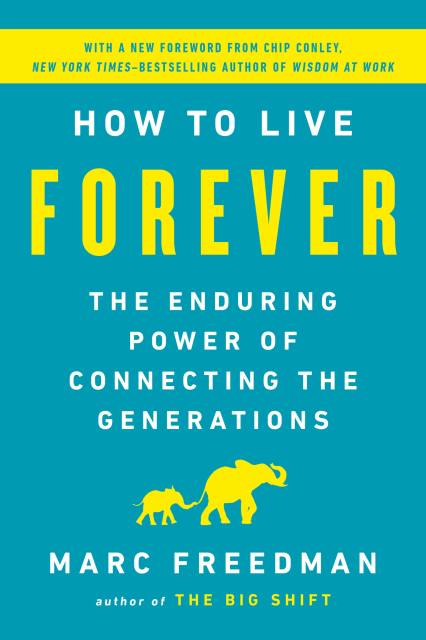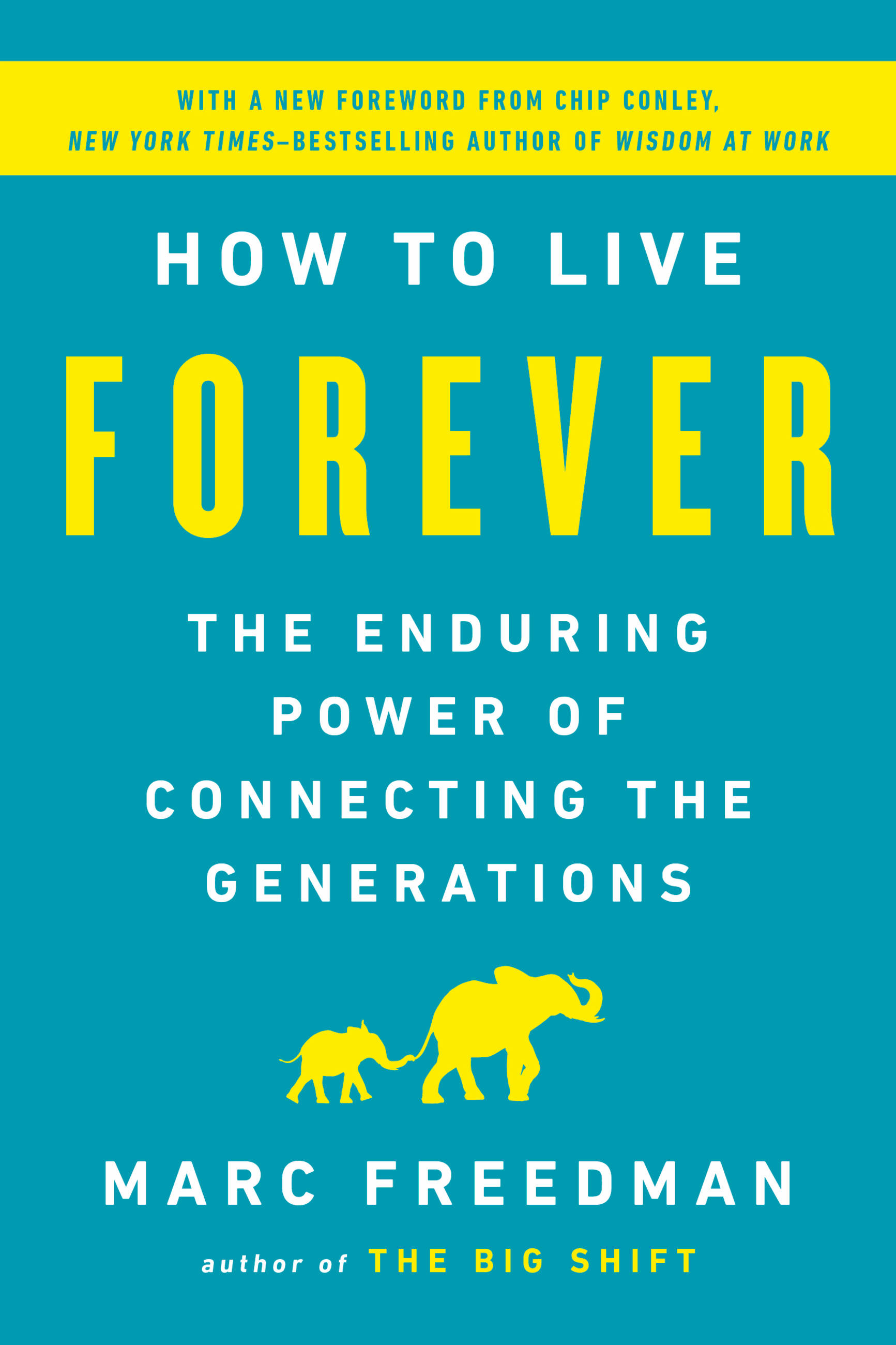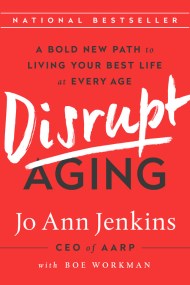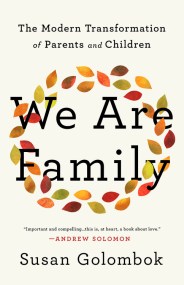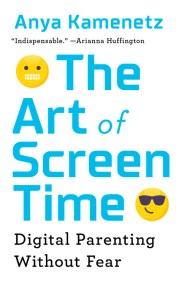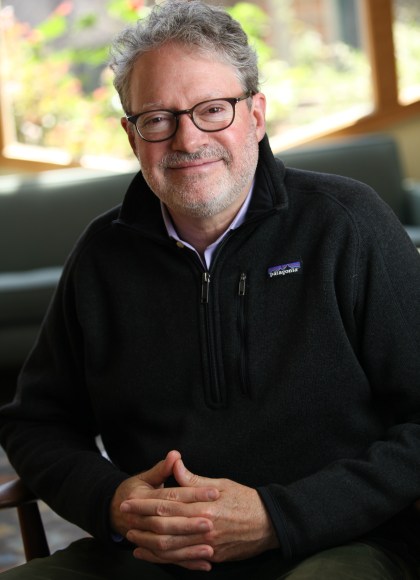Promotion
Use code MOM24 for 20% off site wide + free shipping over $45
How to Live Forever
The Enduring Power of Connecting the Generations
Contributors
Formats and Prices
Price
$11.99Price
$14.99 CADFormat
Format:
- ebook $11.99 $14.99 CAD
- Trade Paperback $16.99 $22.99 CAD
This item is a preorder. Your payment method will be charged immediately, and the product is expected to ship on or around November 20, 2018. This date is subject to change due to shipping delays beyond our control.
Also available from:
In How to Live Forever, Encore.org founder and CEO Marc Freedman tells the story of his thirty-year quest to answer some of contemporary life's most urgent questions: With so many living so much longer, what is the meaning of the increasing years beyond 50? How can a society with more older people than younger ones thrive? How do we find happiness when we know life is long and time is short?
In a poignant book that defies categorization, Freedman finds insights by exploring purpose and generativity, digging into the drive for longevity and the perils of age segregation, and talking to social innovators across the globe bringing the generations together for mutual benefit. He finds wisdom in stories from young and old, featuring ordinary people and icons like jazz great Clark Terry and basketball legend Kareem Abdul-Jabbar.
But the answers also come from stories of Freedman's own mentors—a sawmill worker turned surrogate grandparent, a university administrator who served as Einstein's driver, a cabinet secretary who won the Presidential Medal of Freedom, and the gym teacher who was Freedman's father.
How to Live Forever is a deeply personal call to find fulfillment and happiness in our longer lives by connecting with the next generation and forging a legacy of love that lives beyond us.
Genre:
-
#1 on the Wall Street Journal's list of "best books in 2018 on aging well"
-
"A book that grabs us by the shoulders, turns us toward an important issue, and grips us until we truly see and understand."Kirkus Reviews
-
"'The old and young are built for each other.' On this simple but profound statement, Marc Freedman builds an inspiring and timely manifesto for a better future. As heartwarming as Tuesdays with Morrie, yet deeply researched and enlivened by enough real-life examples to persuade the toughest skeptic, How to Live Forever is both an intergenerational love letter and a practical manual for change. The era of age apartheid is ending, and Marc Freedman's beacon lights the way ahead."Jonathan Rauch, author,The Happiness Curve, and ContributingEditor, The Atlantic
-
"To be happy, what do we need? Strong bonds with others and a sense of meaning. In How to Live Forever, Marc Freedman brilliantly explores how we can foster happier, healthier, more productive lives by connecting the older and younger generations. Freedman illuminates why and how the generations are tremendous untapped resources for each other-and why, as we face a more-old-than-young world, creating this connection matters more than ever."Gretchen Rubin,author of New York Times bestseller The Happiness Project
-
"In this powerful and persuasive work, Marc Freedman shows that the generation gap is far from inevitable. In its place, he offers a compelling vision for the future of intergenerational relations: an alliance of talents that brings joy, empowerment, and abundance to both youth and old age. How to Live Forever is a heartfelt and heartwarming book that will spark purpose in the young and hope in their elders."DanielH. Pink, author of When and Drive
-
"Beautifully written and enormously inspiring, How to Live Forever profoundly changes the conversation about long life and rewrites the generational compact. Read it and be changed."LauraCarstensen, Professor of Psychology, StanfordUniversity, and author, A Long BrightFuture
-
"Marc Freedman's How To Live Forever is a wise and joyful gift to readers of every age."Gloria Steinem
-
"Marc Freedman is one of the wisest thought leaders in the aging and longevity world. With this book, he has crafted a masterpiece, written with deep humanity and insight. This is a soulful rallying cry for intergenerational collaboration like we've never seen before. I finished this book brimming with optimism about our future."Chip Conley, author of Wisdom@Workand Strategic Advisor, Airbnb
-
"In How to Live Forever, Marc Freedman draws upon his lifetime of knowledge and experience as one of the nation's foremost social entrepreneurs and his skill as a masterful storyteller to demonstrate that the only way to live forever is to live together. Arguing that our role as older people is not to try to be young, but to be there for those who actually are, he makes a compelling case that inspires us to connect people of different generations."Jo Ann Jenkins, CEO of AARP and author of Disrupt Aging
-
"Twenty years ago I read Marc Freedman's groundbreaking book Prime Time and it changed my life...inspiring and guiding me as I embarked on my encore career. With How to Live Forever, Freedman has done it again. This extraordinary, insightful, and deeply moving book will touch your heart and remain on your mind long after you put it down. It might even change your life!"Sherry Lansing, former Chairman andCEO, Paramount Pictures, and Founder and CEO, The Sherry Lansing Foundation
-
"Marc Freedman knows that we owe our kids more - more caring adults, more support, more hope, more love. And he knows that we have the human beings - tens of millions of us over 50 -- who can deliver. If you care about kids, read this beautiful, hopeful book, get swept away by the power of its argument and its stories, and step up to the challenge. Surely, our generation can do more to change the odds."Arne Duncan, former U.S. Secretary of Education and author of HowSchools Work
-
"Marc Freedman has written a warm, personal and inspiring alternative to the sorry national narrative of generational conflict. This is an important bookend to Atul Gawande's "Being Mortal" and a humane guide to true immortality."Ellen Goodman, Pulitzer-prizewinning columnist, author, and founder of The Conversation Project
-
"Marc Freedman's How to Live Forever not only makes a compelling case for why it is imperative that we unite people of all ages across a shared vision, but it lays out specifically how older Americans can find purpose and happiness later in life. This is a must-read for anyone interested in creating a more inclusive and unified society for future generations."Michael D. Eisner, former CEO of TheWalt Disney Company and founder of The Eisner Foundation
-
"How To Live Forever is a beautiful guide for helping all of us embrace the journey of life, and contribute all we can at each stage. I'm so grateful to Marc Freedman for sharing this vision of a society that values and maximizes everyone, young and old."Wendy Kopp, Founder of Teach For America & CEO of TeachFor All
-
"'Live mortal,' Marc Freedman advises: accept aging, build meaningful relationships with people of all ages, age-integrate everything-and get cracking. That's how to build the multigenerational world we all hope to live long enough to inhabit and, in the process, create legacies that outlive us. This deeply optimistic book is Freedman's legacy, and what a gift."Ashton Applewhite, authorof This Chair Rocks: A Manifesto Against Ageism
-
"Marc Freedman is today's most insightful thinker about thriving in the second half of life. With personal stories and robust science, How To Live Forever argues that finding meaning is the surest way to happiness, and that investing in the young--rather than competing with them--is the best route of all. Anyone over 40 will love this witty, humble, compelling, and most of all, hopeful, book."Barbara BradleyHagerty, New York Timesbestselling author of Life Reimagined
-
"Forget skin creams and fad diets. As Marc Freedman reminds us, there is only one way to live forever: be useful to others - especially to those coming up behind you. In this wise, inspiring, and practical book he offers us all a clear path to a purposeful life."Eric Liu, CEO, Citizen University and author, You're MorePowerful Than You Think
-
"A beautifully written, often funny, and deeply moving guide to finding purpose and joy in the second half of life, How to Live Forever is a blueprint for making the most of our multigenerational future. I loved this book and you will, too."Henry Timms, co-founder #GivingTuesdayand co-author New Power
-
"In this wonderful, insightful and above all inspiring book, Marc Freedman reminds us that longer lives aren't just about retirement income, keeping fit and the golf course but about engagement and connectivity--connecting together the different stages of your own life and connecting people at different stages of life. With humanity and wisdom Freedman offers a positive view of ageing and life's journey and how as an individual and as a society we should relish the opportunity"Andrew Scott,Professor of Economics, London Business School and co-author, The Hundred Year Life
-
"Longevity is humanity's new frontier, and Marc Freedman is one of its greatest explorers. In How to Live Forever, he charts a path to improved relationships between young and old while providing a cornucopia of ideas for personal reinvention. This is the book we've all been waiting for."Ken Dychtwald, Ph.D., author of AgeWave and A New Purpose: Redefining Money, Family, Work, Retirement andSuccess
-
"This moving, thoughtful book is perfect for all of us who crave more meaning and connection as we age. Highly recommended!"Dan Heath, co-author (with ChipHeath) of Switch and The Power of Moments
-
"Part surprising history, part fascinating sociology, part inspiring manifesto--you close Freedman's book feeling determined to end age segregation, and better yet, crystal clear on how to do just that."Courtney E. Martin, author of The New Better Off: Reinventing theAmerican Dream
-
"One of the best books by a social observer or social entrepreneur I've ever read! Filled with wonderful writing, smart observations, humor, humility and humanity, How to Live Forever will make you hopeful about our individual and collective futures."John Gomperts,CEO, America's Promise Alliance
-
"How to Live Forever isn't just the best-ever title for a book. Marc Freedman has given us an entirely new way to think about our common future, along with tips we can all use to leave an enduring legacy."Sree Sreenivasan, former chief digital officer of New York City, theMetropolitan Museum of Art, and Columbia University
-
"What happens when people from different generations work and play and think together? Fresh ideas for tackling big societal problems, to start. But perhaps more importantly, Marc Freedman shows that intergenerational mixing can produce uniquely satisfying relationships for both the millennial and boomer alike. This book presents an inspiring vision for how we should each endeavor to reach up, across, and down the age bracket to form intergenerational friendships. They will enrich our lives and may even save the world."Ben Casnocha, co-author (with Reid Hoffman) of the #1 New York Times bestseller, TheStartup of You: Adapt to the Future, Invest in Yourself, and Transform YourCareer
-
"Lace up your hiking boots and embark on a path of discovery with Marc Freedman as he traverses the movement of older people connecting with younger ones. His message will motivate you to find "purpose by investing in the next generation, forging a legacy that endures, and leaving the world better than we found it," as he writes in this influential book. How to Live Forever is about possibilities and hope and dreams and, yes, stark reality, clearly voiced by someone I trust and admire, and you will too."Kerry Hannon, New York Times columnist and author of Great Jobs for Everyone 50+
-
"Age is not just a number. It's a beckoning. In Marc Freedman's wonderful book, we meet scores of people who've discovered a passion and purpose in the second half of their lives by helping the young thrive. They needn't be marvelous outliers or heartwarming exceptions. They can be all of us."Paul Taylor, author of The Next America: Boomers, Millennials and the LoomingGenerational Showdown
-
"In a time of escalating social divides, it's not surprising that some forecast a future of intergenerational strife, an inevitable battle for resources and primacy. Marc Freedman sees it differently. In his latest and most compelling book, How to Live Forever, Freedman makes the case for generational interdependence-for the essential bond between old and young. For those in my generation, How to Live Forever is a call to action, offering powerful evidence that we can live more meaningful lives through connection with younger people and contribution to their health, education, and welfare."Paul Irving, chairman of the Milken Institute Center for theFuture of Aging
- On Sale
- Nov 20, 2018
- Page Count
- 224 pages
- Publisher
- PublicAffairs
- ISBN-13
- 9781541767799
Newsletter Signup
By clicking ‘Sign Up,’ I acknowledge that I have read and agree to Hachette Book Group’s Privacy Policy and Terms of Use
